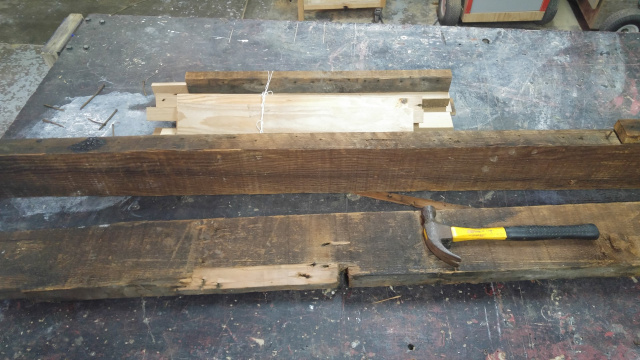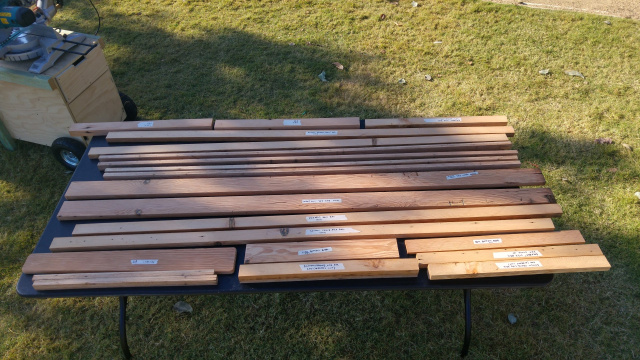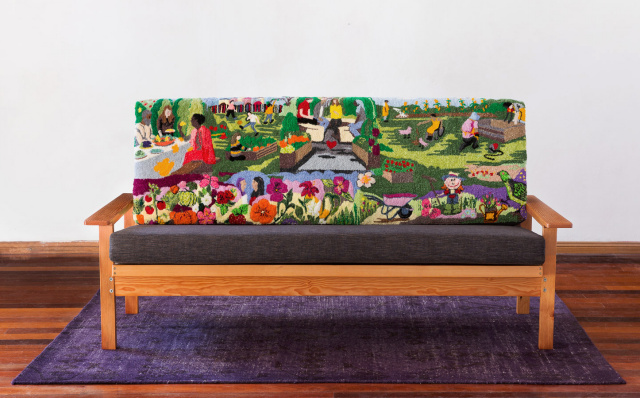
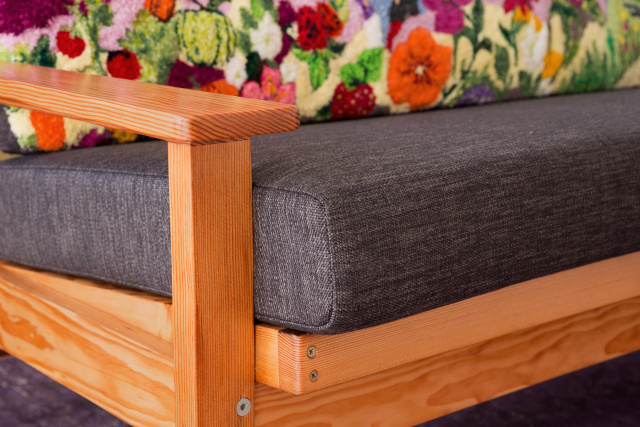
Studio photos by the amazing Amy Paddington
A Social Design project facilitated by Tasman Munro, Jane Theau and Sayd Shah Mahmood.
Hosted by Settlement Services International
1 year, 200 people, many stories
The Tapestry Couch is a collaborative social design project that celebrates the empowering stories of people seeking asylum in Australia, particularly those connected to the Friendship Garden in Auburn. The aim is to make a piece of furniture that sits at the entrance of the community centre to exhibit stories of friendship and healing gathered from the local community. Through it's making the project also intended to hold space for people to spend time with these stories, not just telling them but engaging with them in an immersive way, siting with them, holding them and physically building up imagery around these stories with the hope of creating vibrancy around these small but empowering moments.
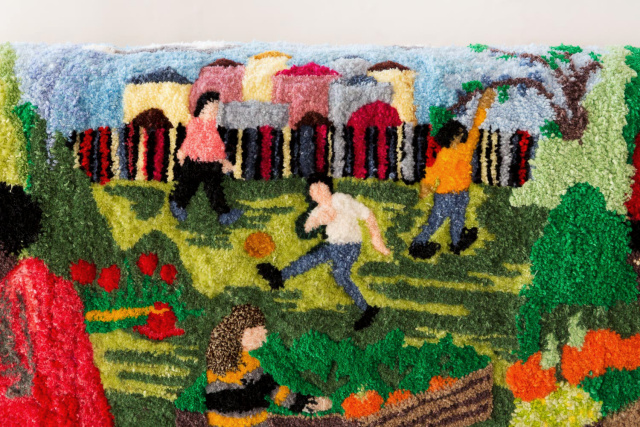
Studio Photos by the amazing Amy Piddington
The making
Myself, textile artist Jane Theau, and master Afghan tapestry artist Sayd Shah Mahmood have facilitate the making through a number of fortnightly workshops at SSI's community kitchen over the past year. Almost 200 people have been involved in its making and during this time Syrian, Tamil, Rohingya, Afghan, Iraqui, Hazara, Persian, Vietnamese and Napalese communities (amongst others) have all sat together, shared their stories and learnt the unique tapestry process from Sayd who’s honed the art form for 30 years…he even makes his own tapestry needles from syringes used to inject cows!
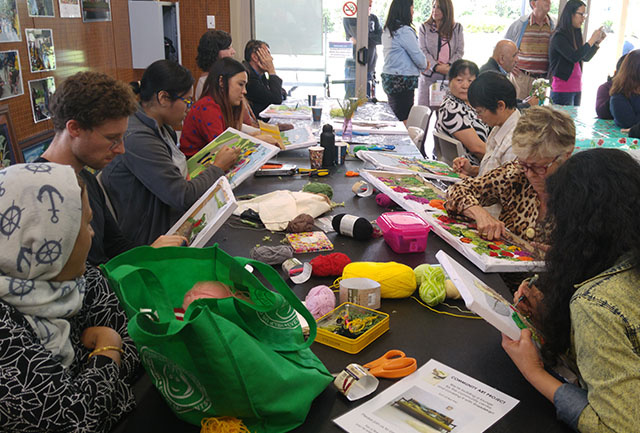
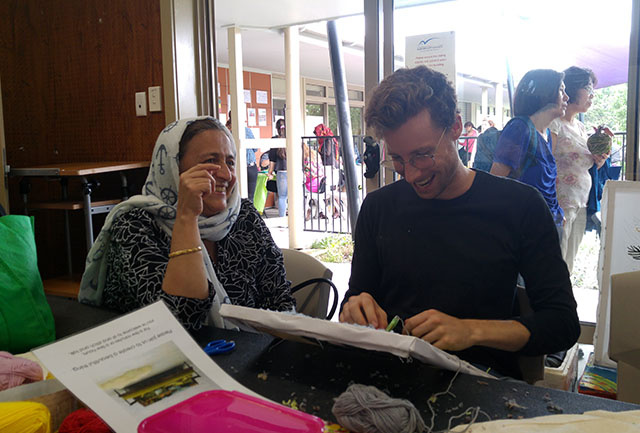
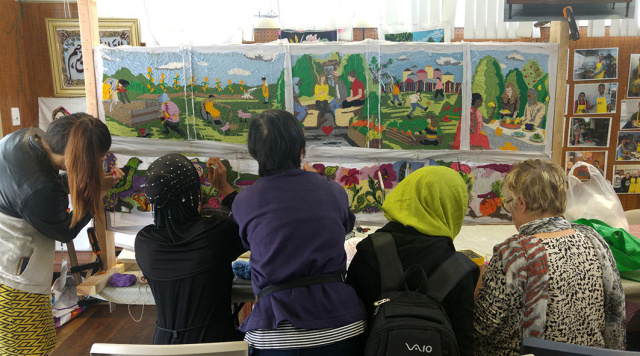
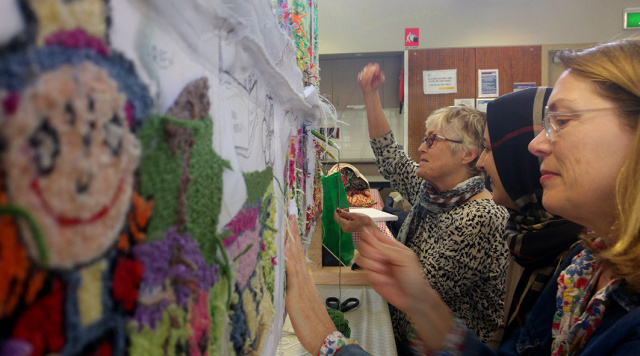
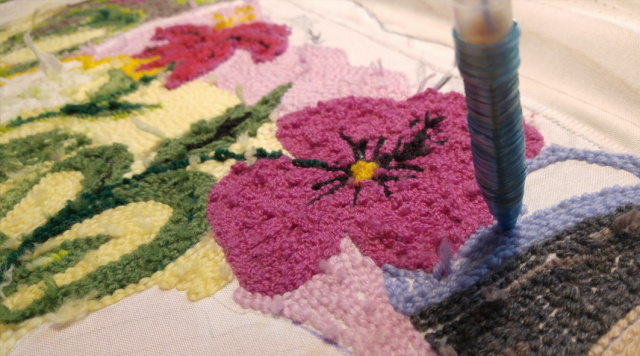
Next week we're starting the woodworking to build the couch itself!
The intentions of the project: A Re-authoring approach to Social Design
The project is being run within my PhD which is exploring a Re-authoring approach to Social Design practice. Re-authoring is a process used in Narrative Therapy that looks to shift the difficult stories that individuals or communities can get stuck in. Narrative therapy believes that people construct stories about their lives by reflecting on a series of past events which they link together into a ‘dominant narrative’. Once these dominant narratives are formed they can begin to define people's identities or influence the way they see the world. This can be disempowering if a dominant narrative is built on a series of problems, challenges or traumatic events, because the story is based on themes of weakness or dysfunction. At times wholes communities of people can also become defined by stories, which can then be further reinforced by social labelling.
Re-authoring conversations look to disarm these problem oriented stories by moving through them and then “spending time” with other, more empowering experiences which may have been overshadowed by the problem story. Moments of strength and resilience or experiences which generally bring life to a community. The aim is not to dismiss that problems exist but challenge the single story perspectives which can form, highlighting that there may in fact be a number of stories unfolding. Whilst listening to people’s accounts of their lives facilitators are double listening, looking for these exceptions which can be richly described and linked together into a counter narrative (White 2007). I'm looking to bring these conversations into design to increase our sensitivities when working with people in difficult places, and learn to move through challenges in ways that are meaningful and engaging rather than just "solving problems". I’ve provided a more detailed summary in a paper HERE
Applying these ideas to design the tapestry image.
This approach was used within the design and making of the tapestry image. The scene in the tapestry was collaboratively designed with members of the Friendship Garden and illustrates a "place of friendship”. We began with a day of story telling where people were invited to share stories of friendship and connection they had experienced within the garden, these stories were then richly described and visualised through drawing and collage. The design was further refined through ongoing consultation with participants. From the stories that emerged people agreed that there was a common theme of healing together and it was decided that the talking circle was a good symbol to be placed in the centre of the garden as it represented sharing and equality. Next there were two types of activities the people spoke about in relation to healing together, one type were stories about a place to keep busy: being active, building together, having a sense of purpose and seeing things grow, these were illustrated on the right hand side of the panel. The other type of activities related to respite and relaxation: sharing food, kicking a ball, picking blueberries after work. These stories were illustrated on the left hand side.

Thickening counter stories
The intentions of Re-authoring is to thicken a counter story through conversations that encourage rich story development, meaning that questions try to get people to link these uplifting events, across time, according to a theme or plot. Within Narrative Therapy White (2007) has developed a Re-authoring Conversation Map which helps facilitators guide people through this process of rich story development.
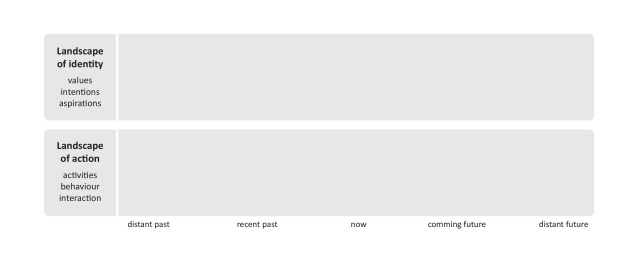
(adapted from Re-authoring Conversation Map White 2007)
The map is structured in a loose timeline and includes two different landscapes (or areas of inquiry), the Landscape of Action and Landscape of Identity. Landscape of action questions ask people to elaborate on the details of the event - what exactly happened, who was there, who said what etc. whilst landscape of identity questions invites people to reflect on the meanings behind these experiences, these are questions about people’s values and aspirations.
Questions continue to bounce back and forth between these two areas and look to develop a richly described history of other experiences which can be linked together into a counter narrative.
Re-authoring Design Map: Adding a third layer.
Using this approach within Social Design my intentions are to add a third landscape - landscape of place. Firstly because every good story has a setting and therefore additional questions about the places in which these experiences happened can assist in the process of thickening counter narratives, but secondly because I am a Social Designer who looks to support social change through the shaping of physical place. Therefore, in these conversations I’m also asking “where did this story take place”, “what was around you”, “how do you think the physical place or things around you helped you behave/feel in in this way?” etc. Within these conversations the aim is to develop a rich history of empowering experiences along with their connection to physical place, learnings which can then be built on when future gazing, in a process that looks to co-construct new social narratives alongside the design of physical places that could support these narratives to flourish.
For example, one man from the garden said that his family was in a difficult situation back in his home country, “I am very worried, but when I come to the garden I can forget and relax”
The man introduced himself through this story of worry and spoke about it in ways that seemed like the worry consumed much of his thoughts. We became very aware that his situation was real and difficult and tried our best to hear and validate this challenging story as well as acknowledge the effect it was having. Although we could not change this man's situation Re-authoring questions could help create a little distance between this all consuming narrative of worry. His words "when I come to the garden I can forget and relax" suggests that the worry isn't always there, which provides an entry point to begin building up a counter story of other moments he has gotten the upper hand on worry.
Below is an account of our conversation
Find exception: Can you think of one particular time in the garden you have been able to forget this worry?
Yes, this week when I was gardening
Landscape of Action: What was happening?
I was busy, planting
Landscape of Identity: And how do you think that helped? What was special about that activity?
It was peaceful
Landscape of Place: was there anything else around you that helped you feel peaceful?
Nature, and trees, I was putting my hands in the ground
Landscape of Action (looking for other story): Are there other times you have also forgotten your worry when you’ve been planting?
I have also just planted some corn. I like it very much.
Landscape of Place: Where did you plant the corn?
In the back of the garden, we have our own plots
Landscape of Identity: And what do you like about the corn so much?
It’s good to see things grow.
On the Re-authoring Design Map this looks like:
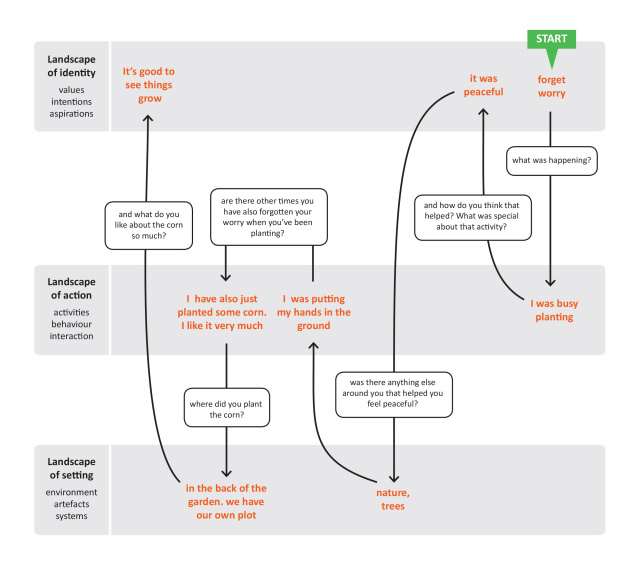
The conversation was then concluded by inviting reflection on the overall meaning by asking him to name the counter narrative: So what do you think all these stories are about, why are they important, or what can we learn from them?
"Gardening is healing", the man said.
Despite the language barrier between us which meant the descriptions were short, a few brief questions allowed us to start building up a counter narrative of gardening as healing. We learnt that keeping busy and planting individual crops are activities that support this narrative and a physical place that gives him his own plot to connect with nature and put his hands in the ground is important. We also learnt that this counter narrative links to his values of finding peace and seeing growth. Although these ideas are pretty simple at this stage the map helped to start moving the conversation across the three landscapes, a valuable process to start building up people’s awareness of the connection between activities, meaning and place. As the conversations progressed with participants over the following months they began to move themselves through these levels. A valuable position to be when collaboratively designing new places.
Although this project does not include the designing of a physical space it did include a process of imagining a place of friendship and healing, what activities would be happening, how would people feel and what could the place look like. So the conversations were similar and the tapestry design is almost like a concept sketch.
Spending time with empowering stories
The journey of hand making the tapestry over the past year has been a long and intricate process that’s encouraged people to physically spend time with these stories, literally building them up, whilst telling and retelling them to each participant group. The hope is that this process has amplified these stories of strength and resilience, put energy into them and connected them to new audiences. In that sense it could be referred to as what Narrative Therapy calls a Narrative Document, an artefact that rescues the words of participants, presents them back to them as well as connects these words with broader audiences. The aim is that the couch will sit at the entrance to the community centre, further achieving this goal, as people enter the space they will be continually reminded of the empowering stories connected to that special place and presented with a vision for the garden’s future.
A massive thanks to everyone who has contributed so far, and to a team of dedicated volunteers, in particularly Sarah Webber for hours of help and facilitating extra workshops at SSI's Humble Creatives and Diana Nguyen, Judy Embrey, Margaret Gallagher and Jack Fahy for offering ongoing project support and Lucy Klippan for assisting with the Design Workshop
Reference: White, M., 2007. Maps of narrative practice. WW Norton & Company.

The Making of the Couch Frame
17/05/17
Today we finally got round to building the timber couch itself! Surrounded by music and dancing at this week's Community Kitchen Jane led a group to put the final touches on the tapestry whilst we hit the power tools with another group to build the timber frame. It's almost finished!
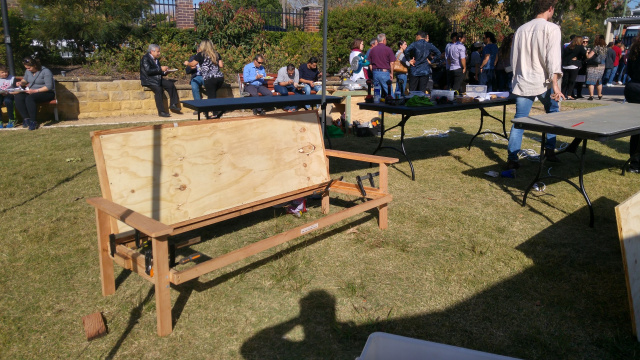
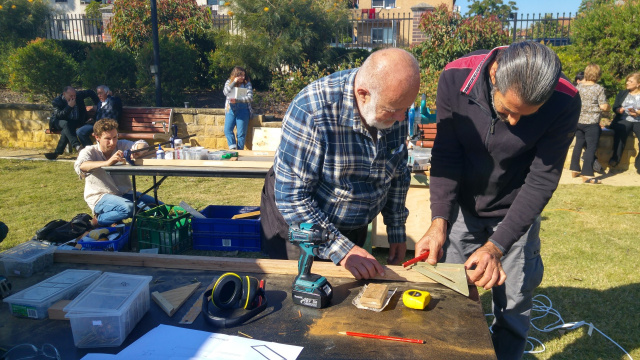
The frame is made from recycled Oregon roofing beams that a friend donated from a house he was demolishing.
